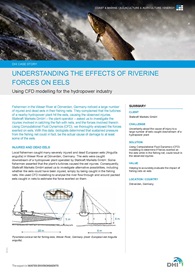 We used Computational Fluid Dynamics (CFD) modelling in order to investigate injuries and deaths caused to eels caught in fishing nets, downstream of a hydropower plant in Germany.
We used Computational Fluid Dynamics (CFD) modelling in order to investigate injuries and deaths caused to eels caught in fishing nets, downstream of a hydropower plant in Germany.
Local fishermen caught injured and dead the eels in the Weser River at Dörverden, Germany, downstream of a hydropower plant. After some of them claimed that the plant’s turbines caused the eel injuries, Statkraft Markets – the hydropower plant operator – asked us to investigate alternative causes.
We used CFD modelling to analyse the river flow through and around packed eels caught in fishing nets to estimate the force exerted on them:
- environmental force
- flow resistance force
- turbulence force
- fishing net force
The environment (the weight of the river and the atmosphere) exerts pressure on the eels even when they are not caught. The pressure is about 10,000 kg/m2 (or 1 bar). Other forces exerted on the eels are a small percentage of this: 3% for flow resistance force and 2% for turbulence force. However, under certain conditions the force exerted by the fishing net can reach up to 300%.
As such, it is possible that the fishing net itself caused some of the observed injuries. Under large tensile loads (for example, when a net is packed with eels), each part of the fishing net becomes unyieldingly hard. Eels pressed into such a tight net for hours are likely to suffer skin lesions and bruises. Based on this data from our CFD simulations, biologists determined that the injuries sustained by at least some of the fish could have been caused by the fishing net.
In addition, eels can die of exhaustion when swimming in strong currents for long periods of time. This can occur when the eels swim against currents as low as 0.5 m/s in hydropower plants. In our CFD simulations, the calculated current speeds are substantially stronger than in existing literature – ranging from 1.6 -1.9 m/s at the front to 0.8 m/s at the back of the fishing net. Based on these results, exhaustion may have contributed to death of some of the eels.